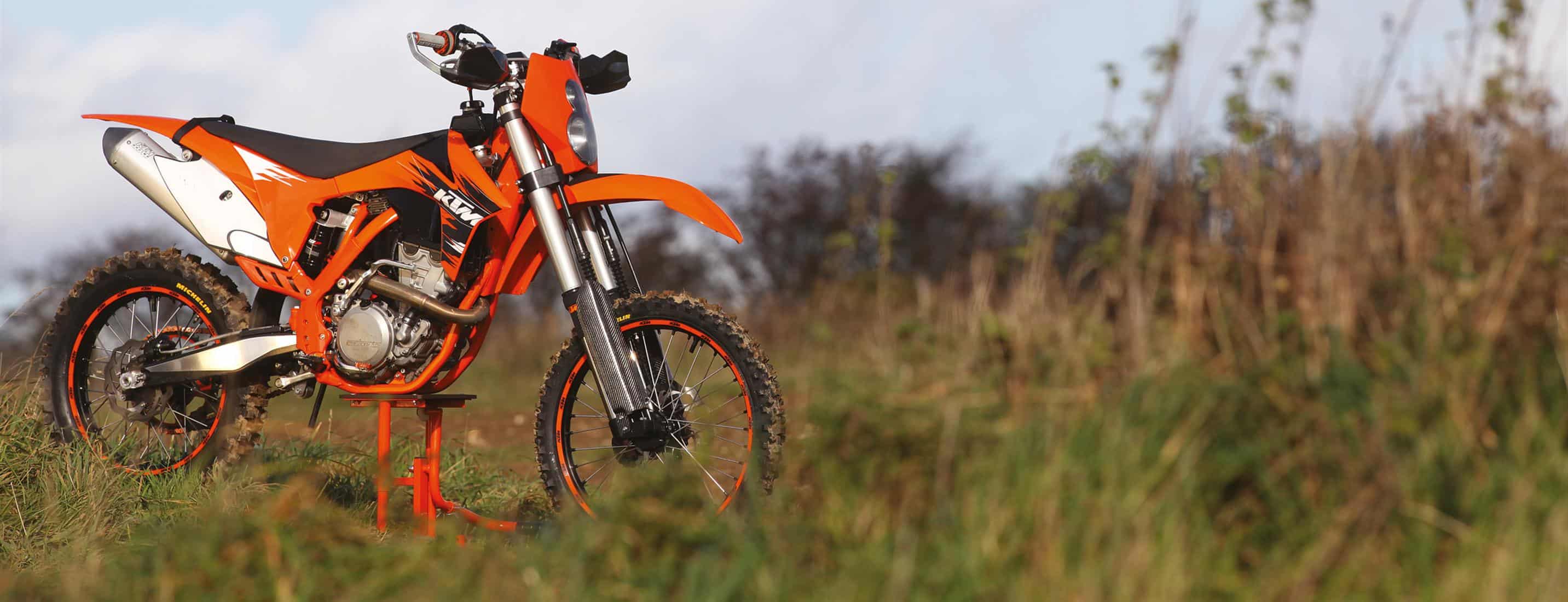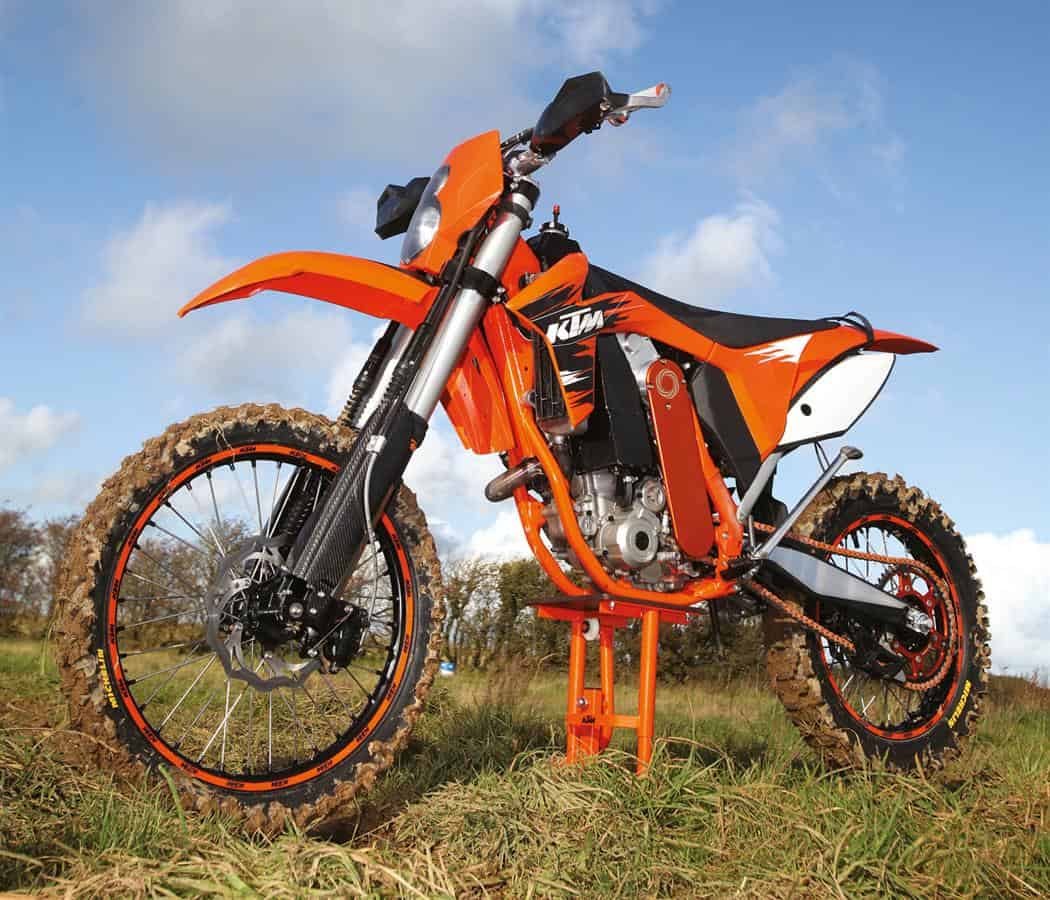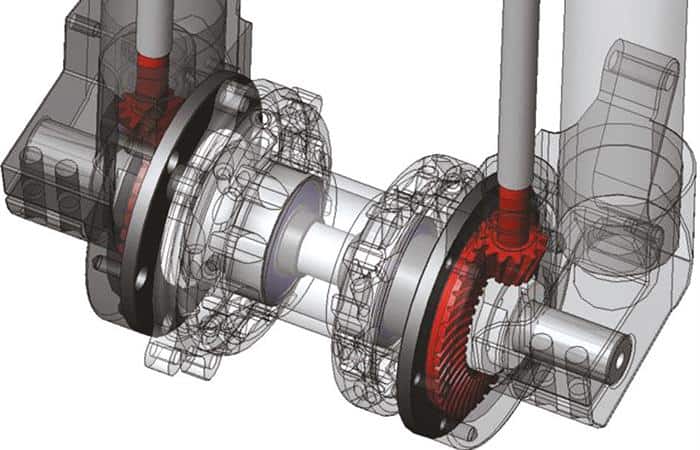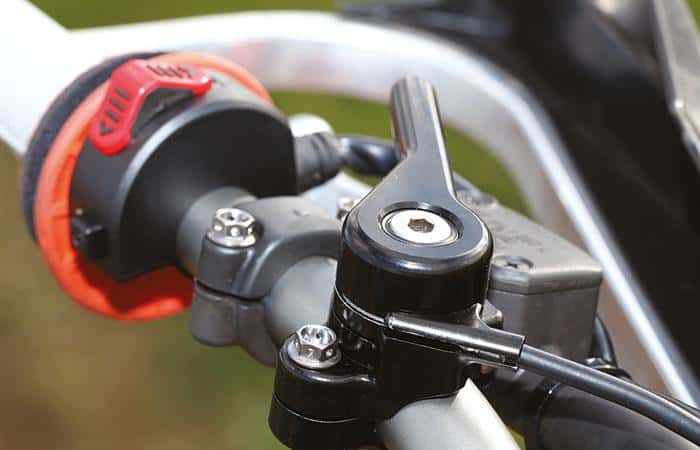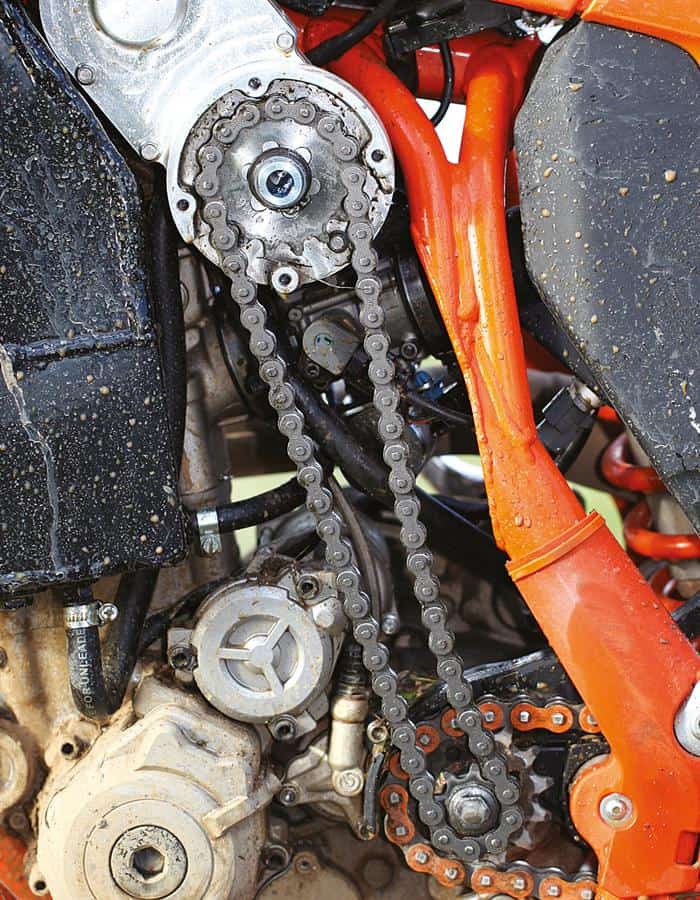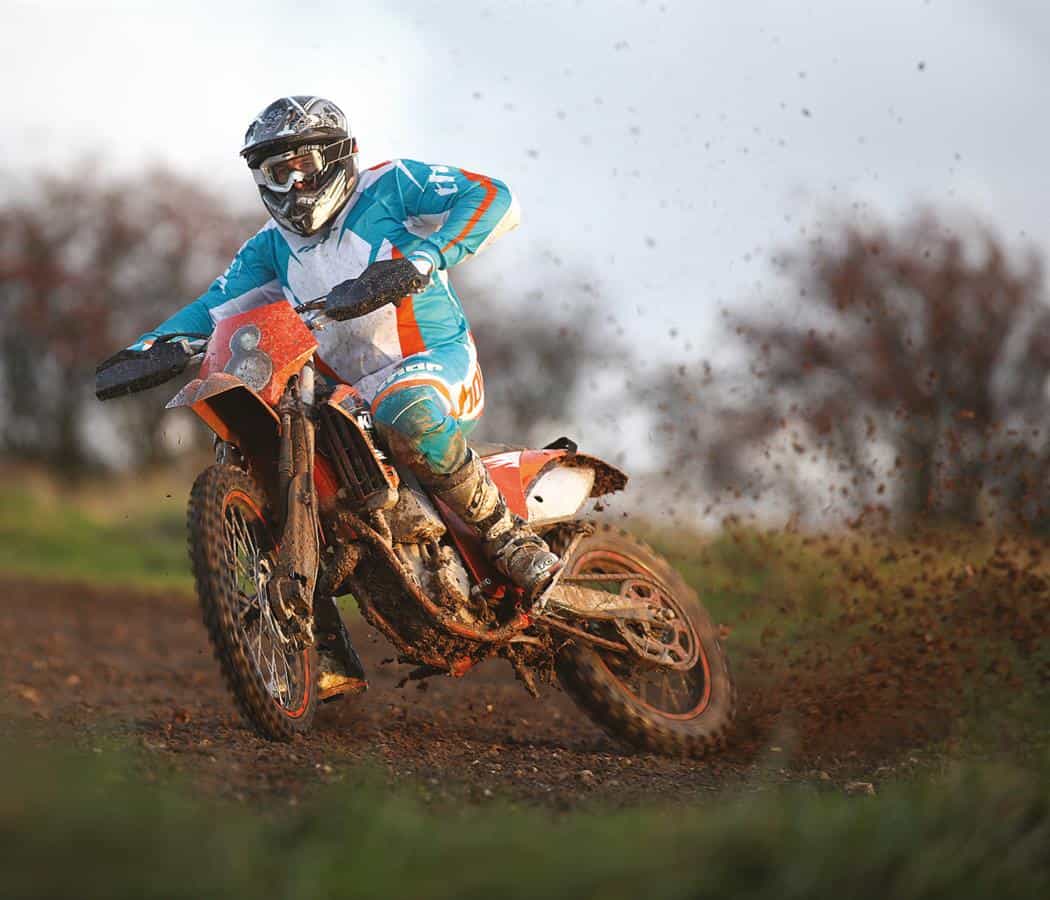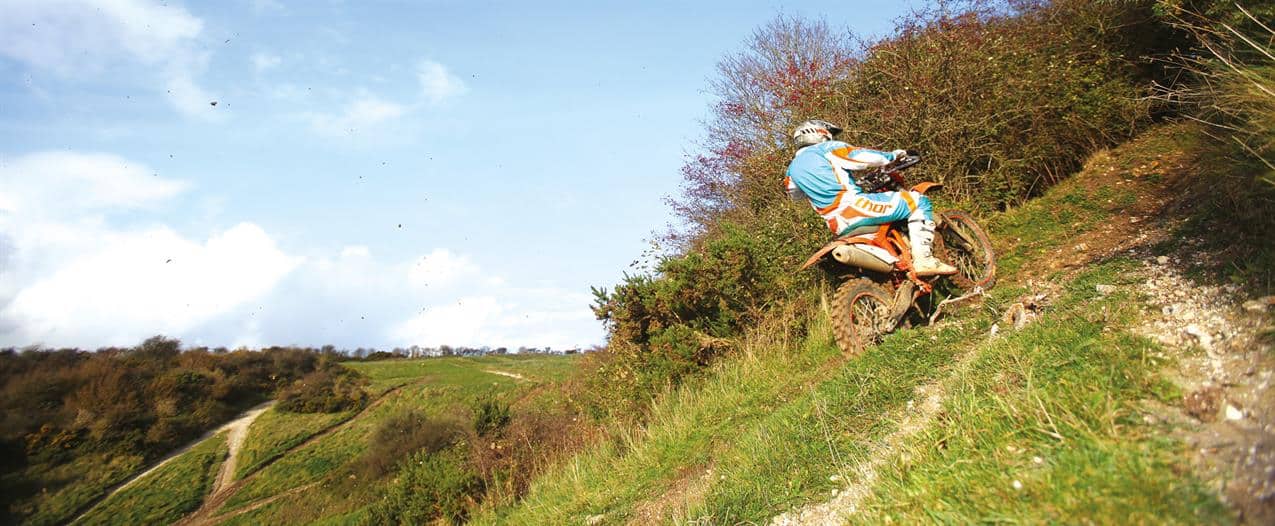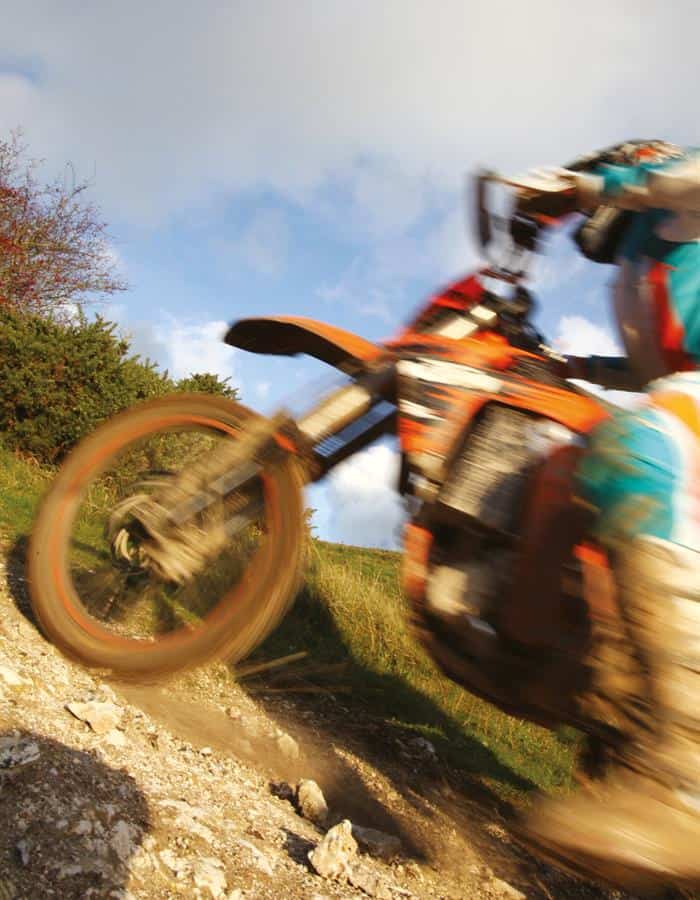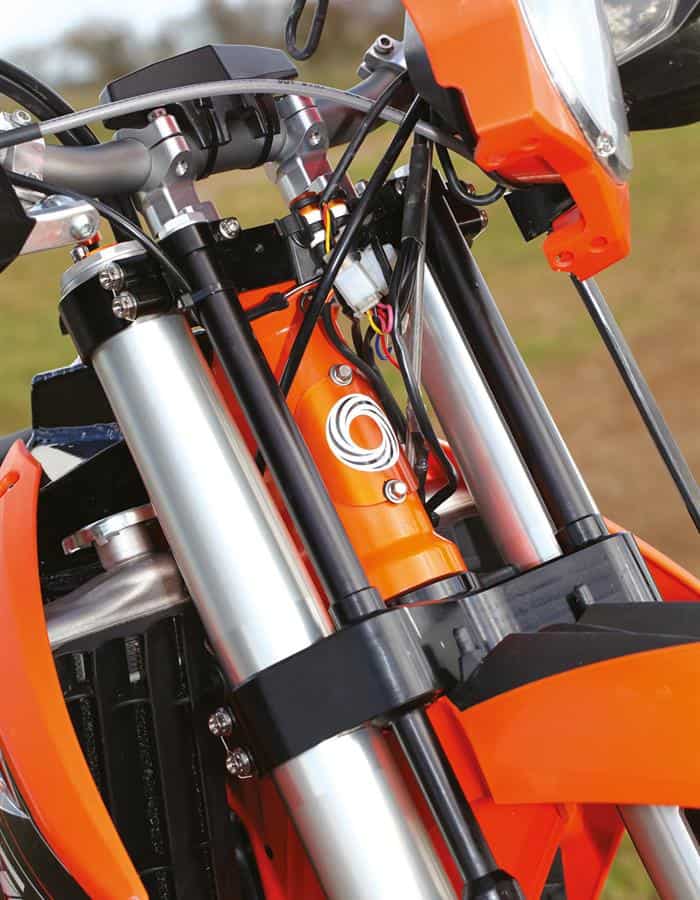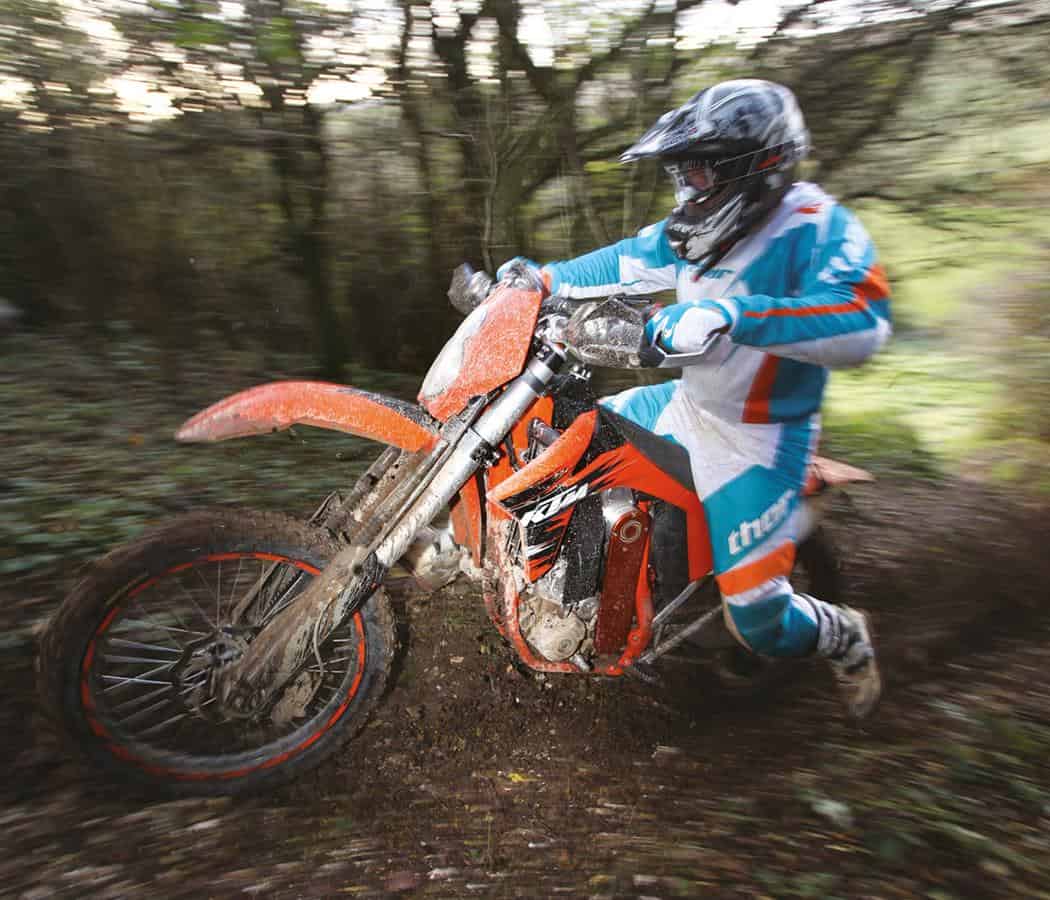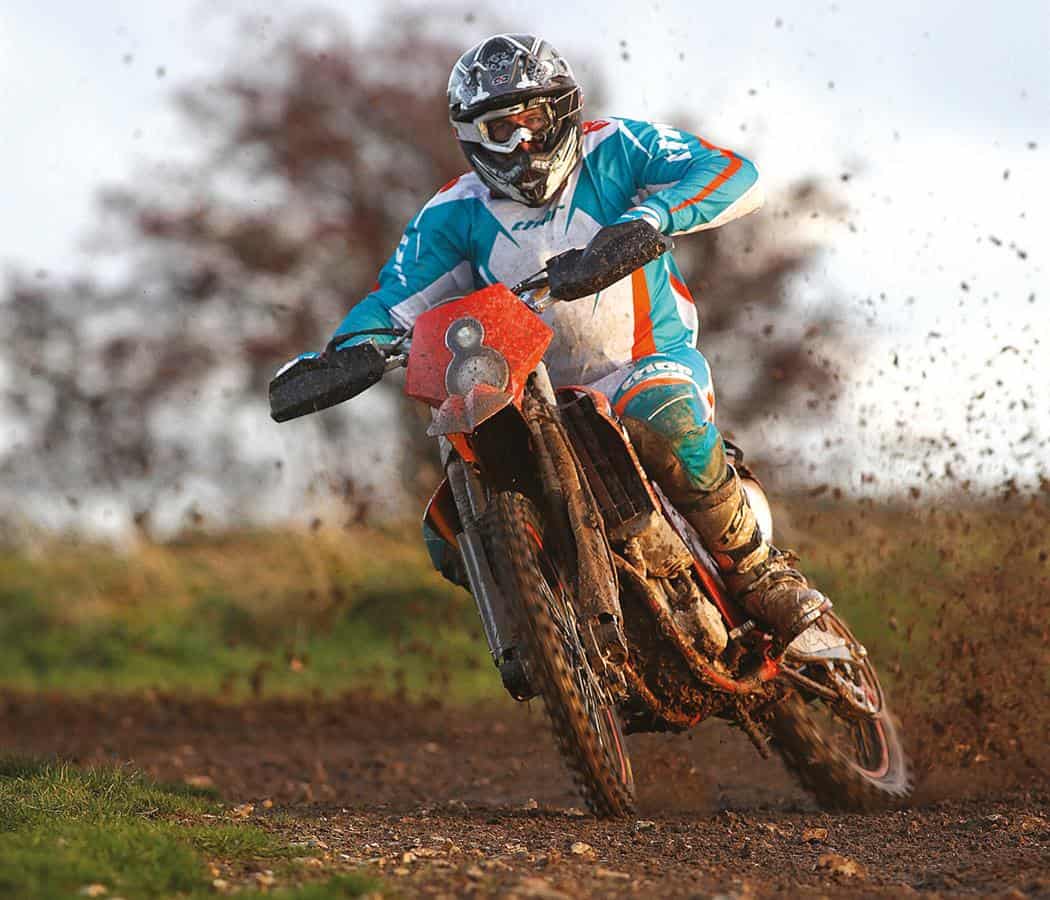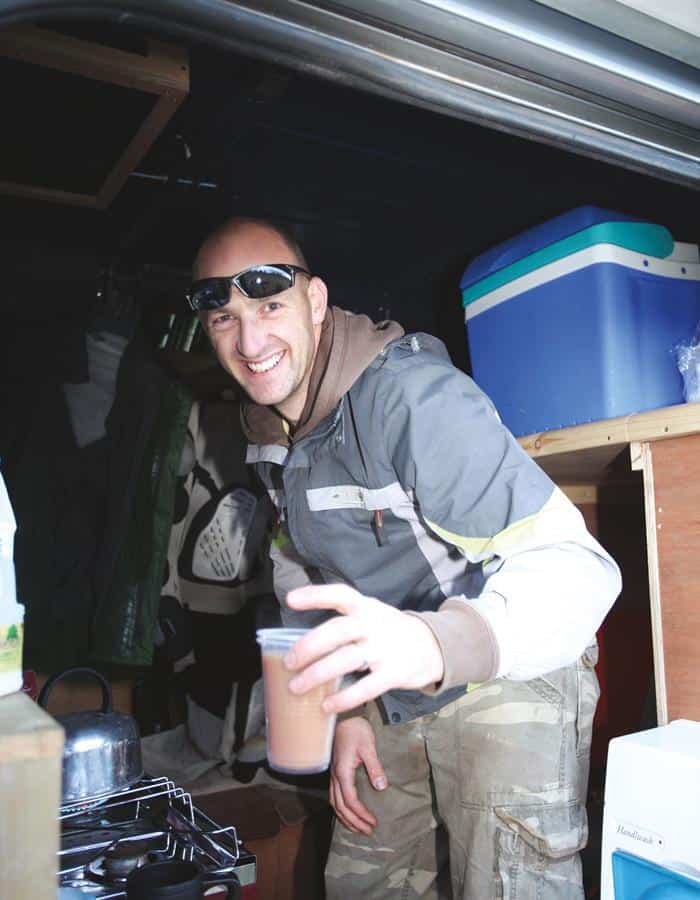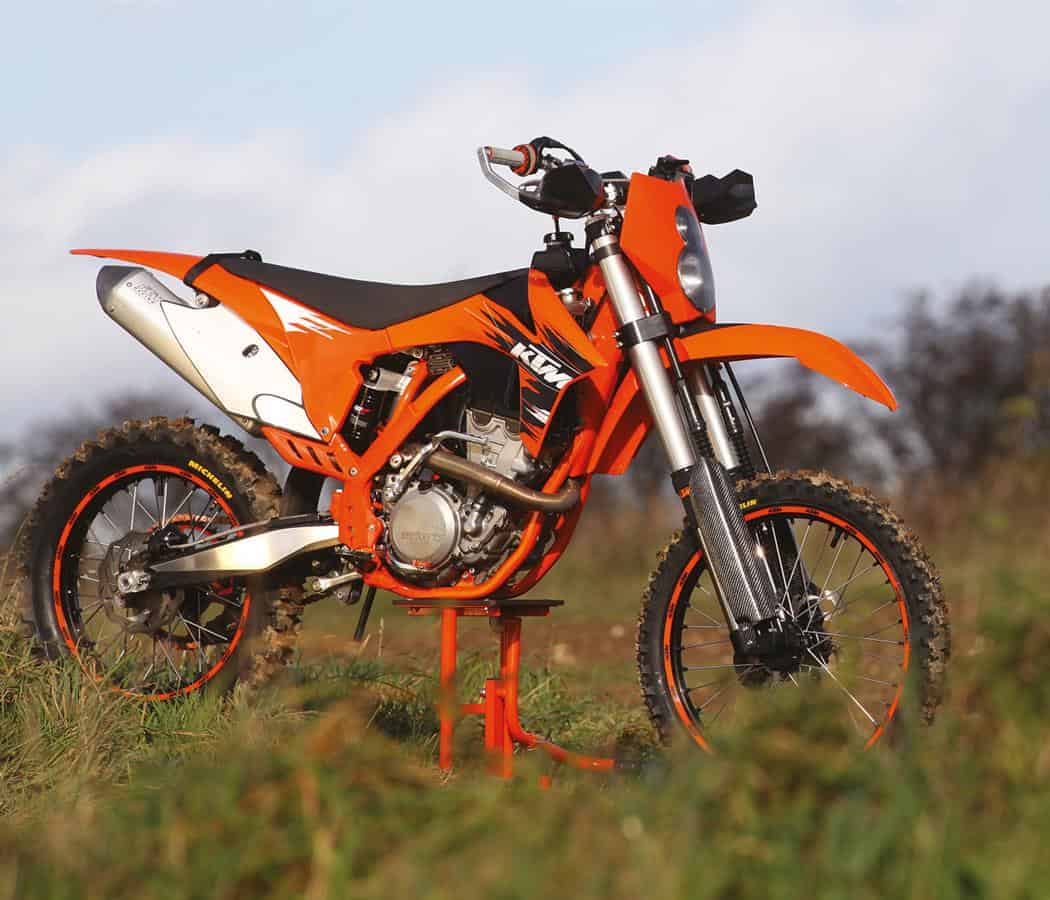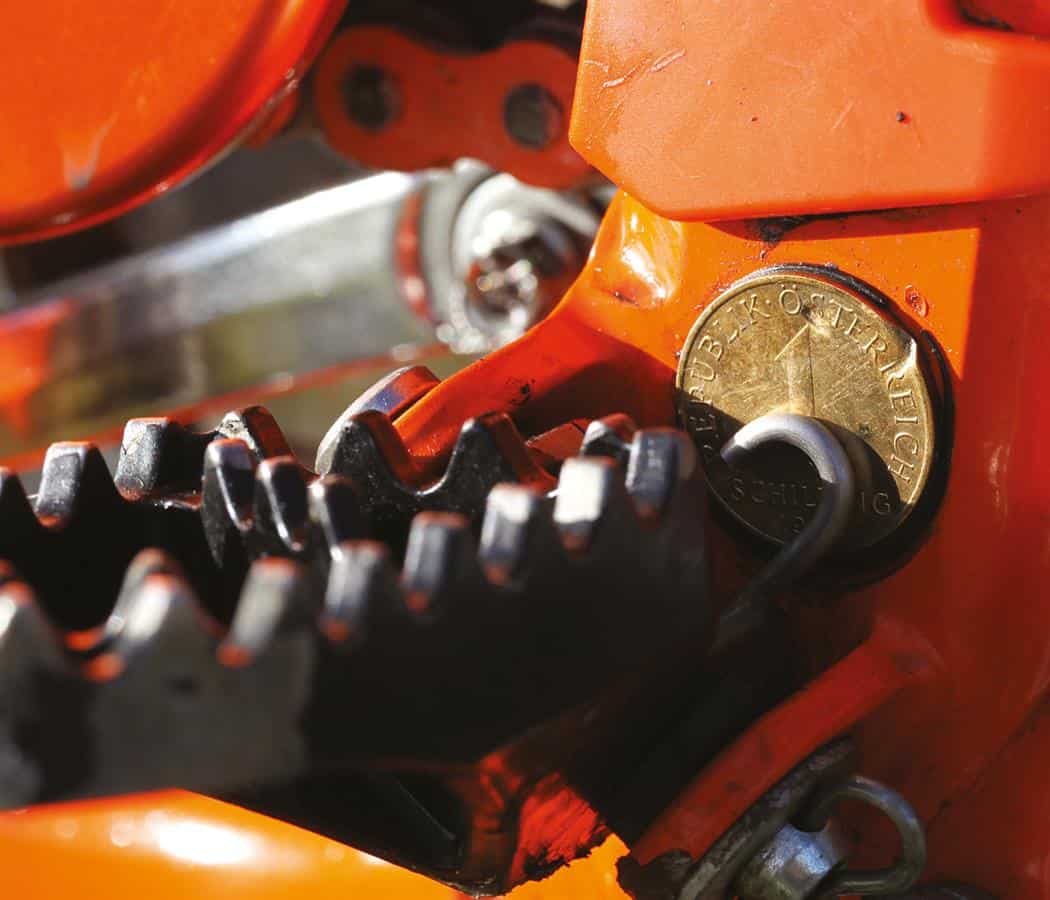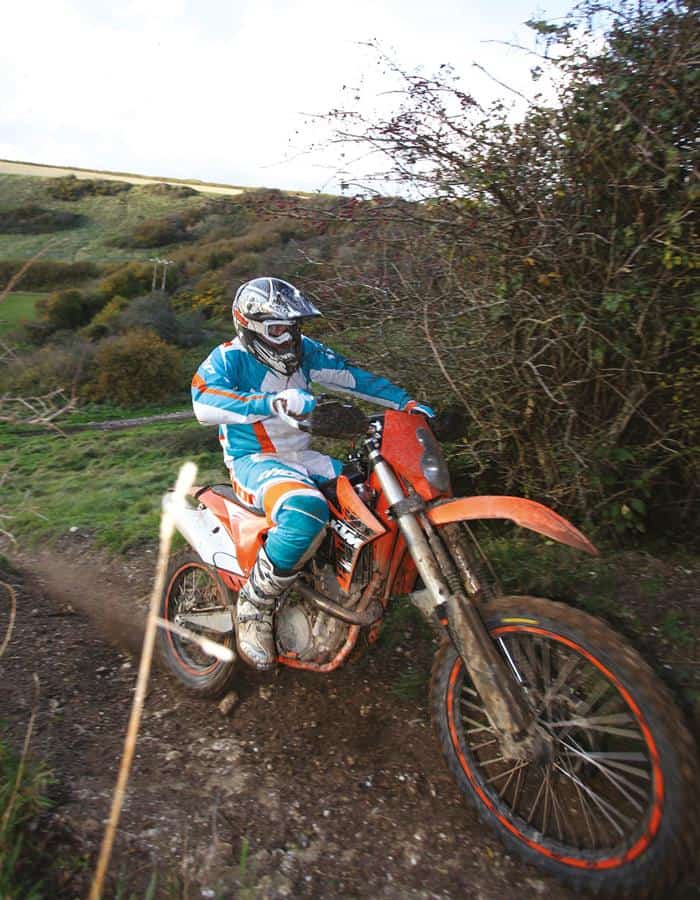Ian Wall owns the world’s only two-wheel-drive KTM 350, and he offered it to RUST for a day to try it out for ourselves, on a slippery Dorset test track. Oh yeah baby…
It was one of those hills that from a distance hadn’t looked TOO bad. Steep, yes, and without any sort of run-up thanks to an awkward 90-degree turn at the bottom, but certainly do-able even in winter I reckoned, especially given that I was riding that rarest of dirt-bikes, one fitted with Two-Wheel-Drive. I stuck the Christini KTM 350XC-F into second gear and turned up the hill to begin the climb.
Even before I’d got very far, I realised just how awkward it really was. The track had a narrow v-shaped rut that limited your choice of lines. Perhaps more significantly it was carved into wet chalk – one of the slickest substances known to knobbly tyres. On top of the chalk was a greasy surface-dressing of slimy clay that had washed down from the surrounding soil to ensure that any potential grip was fully eliminated. But that wasn’t all…
Towards the top it was heavily overgrown and a tangle of tree-roots pierced the surface of the track, disappearing off at an angle to the climb. And just for good measure a series of bumps unsettled the drive, so that if you DID find grip, it wouldn’t last for long. This was gonna be the perfect test of a two-wheel-drive dirt bike. If anything could claw its way to the top, then this baby would do it. It had the engineering, it had the power and it had a rider that had absolutely no intention of shutting-off on a hill this steep!
I gritted my teeth, cracked open the throttle and felt the bike respond (with a little kick) beneath me. Three quarters of the way up, the rear tyre which had been scrabbling for grip like a puppy on a polished floor, began gyrating wildly, that was the signal for the front end to fully kick in and take over. I threw my weight forwards and urged the bike onwards, but it was no good, another few metres further on it ground to an ignominious halt. Ha! I thought to myself… so much for two-wheel-bloody-drive then…
I grabbed the rear brake, slid off the side of the seat and began manoeuvring the bike on the hill – grabbing the rear fender and hauling on the rear end so that the bike sat sideways across the hill. Heading down again looked more difficult than coming up so I went to select first gear and that’s when I noticed the strange lever on the bars – just above the clutch lever. And then I remembered Ian – the bike’s enthusiastic owner – telling me that this lever allowed you to engage two-wheel drive. Pulling it back disengaged the drive for when you wanted the bike to behave just like a normal dirtbike, whereas pushing it forward selected all-wheel-drive. And guess what..? it was in the rearward position. You plonker Rodney!
I slid the lever forwards and listened intently as the mechanical system engaged with a faint clunk. Yup, NOW it was in all-wheel drive… There was only one thing I wanted to do right now: have another crack at this hill. I turned off to the side, gradually edging my way back down the hill, until I hit the track at the bottom, then spun the bike around and headed for the climb once more.
As I turned up for a second time I saw the tell-tale marks on the ground where the bike’s rear tyre had been spinning the entire way up the hill – not surprising really, given how much rain we’d had over the previous few days. This time however, something felt subtly different, the bike was tracking over the ground in a similar way, but felt slightly more sure-footed, a bit more stable and straighter on its line.
As we neared the point where it had ground to a halt before, I threw my weight forward up the seat towards the front of the bike and kept the throttle on. The rear tyre was spinning continuously now but a strange thing happened… instead of grinding to a halt as I’d half expected, the bike continued to climb the hill. Not in a jerky way, but maintaining a steady momentum – onwards and uppards! There was no crabbing from the front end or difficulty controlling the bars, the bike just continued to keep moving forwards, finding grip and using it to haul the bike up the slope.
The transition from predominantly rear-drive to all-wheel-drive was seamless, and in all probability had most likely been happening all the time the bike was climbing. Most two wheel-drive bikes are geared so that for approximately every 1.5 rotations of the rear wheel, the front wheel turns once. This is so that you don’t continually ride a front-wheel drive bike (because the rear seldom has 100 percent grip), and to prevent the bike suffering too much torque-steer. Of course they all require free-wheeling front hubs (as this one has) in order to work properly.
The bumps towards the top of the hill lifted the rear wheel but it squatted back down, settled and then began driving again, whilst the front tyre continued to claw its way, up and over the root-fest at the steepest part of the climb. Suddenly we were over the worst and into the bushes at the top of the hill – it was still amazingly slippery as no bikes had ridden it for a few weeks, but the Christini was well into its stride now. It kept on pulling, kept on driving and kept on going, till we emerged triumphant out the top of the climb onto open hill. YESSS!
By this stage the bike’s owner had spotted what I was up to and clambered onto the hill to get a better look. And along with Barni the photographer, they shouted for me to repeat the feat for the camera. Again and again in fact. I must have climbed that goddamn hill at least 20 times that day, despite the surface getting slicker and slicker with every pass, as both wheels spun on the chalk and wore away any last vestiges of grip. Yet the 2WD Christini never failed me. Yep, this thing is awesome alright, and no mistake…
Drive Time
I confess I’ve got a real soft-spot for bikes like these – technological marvels that use clever engineering solutions to overcome an off-road motorcycle’s inherent weakness of only ever having a single driven wheel. If it was up to me, all bikes would have selectable two-wheel drive fitted. I know they don’t actually NEED it most of the time, but boy when you DO need it, then it’s bloody useful to have.
Of course most of you will remember back in 2003/4 Yamaha and Ohlins jointly developed a high-tech fluid-drive system that they fitted to their WR450F and briefly marketed that machine as the 2-Trac. We tested that bike in various guises and in various terrain, (from desert sand, to Welsh mud and even on a tarmac circuit in SM guise) and absolutely loved it. To me it almost revolutionised the way a dirt bike works and feels in slippery going. It was typical of Yamaha to come up with that product – innovative, well engineered and too far ahead of its time for its own good. Most punters gasped at its technological brilliance but still chose to ignore it.
It wasn’t so much the weirdness that put people off as much as the expense. It was pricey: at over eight-and-a-half grand it almost doubled the cost of the standard machine at the time. And it was kinda complex (so is the Christini of course). Plus there was a weight AND slight handling penalty, that you could feel most of the time you rode it.
On the other hand what a lot of fun it was when you got to a bog or slippery bombhole, or even just accelerating away from the line – you simply couldn’t fail to get the holeshot on your mates riding a 2-Trac: ‘See ya suckers’. I maintain that the whole reason we ride dirtbikes is for the fun they give us, and all-wheel drive simply adds a new dimension to that fun.
The Christini of course uses a completely different system to the (space-age) fluid-driven 2-Trac, opting instead for a more conventional and entirely mechanical system of chains, gears and shafts to transfer power forwards to the front hub. This thing is essentially a nut-and-bolt bike.
And whereas the 2-Trac was more or less a bolt-on/removable system, the Christini requires wholesale alteration to the bike’s frame – including cutting and remodelling of the left side frame rails to make room for the secondary chain drive as well as the complete removal of the standard steering head, so that the frame can be machined to accept a driveshaft running up the bike’s backbone. Then, the re-machined steering head (that has the necessary drive components installed) is welded back in place.
If that all sounds horribly complicated, well the truth is … that it is. But don’t worry – Christini (in America) do all that for you. All you need do is supply them with your frame and a cheque for $3,300 USD (in 2011), and it comes back to you fully powder-coated (in your choice of colours) and ready to be fitted back into your bike. Remember this price includes, the frame alterations, all the necessary componentry including new lower triple clamps (these house some of the drive gear), as well as the new front hub.
Two by Two
So how does the Christini work? Well, drive to the rear is conventional using a front sprocket driving a chain – so far, so normal. However on the Christini the sprocket that attaches to the output shaft has a second – smaller – sprocket welded on the front-side (the number of teeth on this sprocket dictates the ratio of power delivered to the front, and indeed the torque applied). This second sprocket drives a chain that runs up the side of the engine (behind the lozenge-shaped orange cover you can see in the pictures), to a small ‘gearbox’ located just under the tank. The gearbox transfers drive from the chain to a shaft that runs up the backbone of the bike, all the way to the headstock and is also the point at which drive can be ‘de-selected’ using the lever on the bars.
In the middle of this shaft running forwards up the bike’s backbone, is a tiny (manually adjustable) clutch unit, that I can only assume is there in order to break the drive should something jam in the 2WD system. Anyway, after the clutch the drive shaft continues forwards and exits in the new steering head, where it drives a pinion gear. This in turn drives an upper and lower pinion wheel that sit in the chunky (hollow) lower triple clamp. Because the drive shaft engages one ‘cog wheel’ above it and one below it, they each turn in opposite directions and each drives a small chain (all located within that lower triple-clamp), and each chain then drives a small driveshaft located just aft of (and running down the front of) either fork leg.
Now this is the really clever bit… not only do these drive shafts have to transfer power down the length of the forks all the way to the front hub (where they drive the front wheel using a bevel gear on either side), but because of the long travel suspension on a dirt bike, they have to be able to compress in order to take up any movement at the same time. So they are in effect, compressible/ extendable driveshafts!
Interestingly – unlike Yamaha – Christini elected to take drive to BOTH sides of the front wheel, which in theory should help minimise torque steer. Certainly there was no evidence of any kind of one-sided steering load on this bike, whereas the Yamaha 2-trac required the standard fitment of a sturdy Ohlins steering damper (to a bike generally renowned for its stability), in order to suppress unwanted steering forces.
The engineering that’s involved in order to take drive forwards to the front wheel on the Christini just has to be seen to be believed. It really is quite amazing in its design and conception as well as being beautifully executed. It may seem a complex way of doing things (actually it IS complex, compared with a pair of flexible hoses transferring and returning a fluid), but there are a lot of turns, angles and issues to overcome on a dirtbike using a mechanical system like this – not least the way a bike steers and suspends the front wheel. Looking at the finished product I’m tempted to say that this is American engineering at its best. On the other hand I dread to think how many bearings, seals, cogs, joints and other moving parts will require maintenance (or at the very least a quick check over) come end of season.
Clearly this daunting task is not enough to put off the bike’s owner – Ian Wall – who is relishing the task of tearing it all down over the Christmas holiday and setting to work making sure it’s all running smoothly in time for next year. Because understanding the owner goes a long way towards getting to grips with the rationale behind a machine like this. Allow me to explain.
Ian is not a rich man, nor is he some kind of engineering genius, though clearly he’s happiest when up to his elbows in assembly oil. But what Ian is – first and foremost – is an enthusiast. And a fairly obsessive one at that, judging from the £2000-worth of drilled titanium bolts that now bedeck the machine. Not surprising really, it goes with the territory.
It takes a certain type of person to purchase a brand new and perfectly good 350XC-F and then break it down into its constituent pieces in order to ship the frame off to America to be cut-n-shut. It’s hardly going to appeal to most readers, and nor will the additional cost and servicing required in maintaining a complicated two-wheel drive bike like the Christini.
But talking to Ian you get the distinct impression that this is the VERY REASON he has elected to build and run this bike – because it’s different from the norm and other run of the mill machinery! And that’s the whole point. It’s not simply about being different just for the sake of it, it’s about the extra challenges (and rewards) a bike like this can bring. And clearly Ian enjoys a challenge or else he wouldn’t have started this whole project.
Ian Wall is no stranger to motorsport… In the past he’s been involved with Speedway, road racing, and Formula Ford, and it’s only in the last few years or so that he has come over to the dark side and started racing enduro. And now he’s loving it…
So what made him want to opt for a 2WD bike, I ask?
‘I liked the idea of it and I wanted to see how it would work on a dirt bike. I’m not worried about the extra maintenance, it’s all part of the fun for me; although looking through the technical manual that came from Christini it does all look fairly complicated!’ He concedes with a chuckle.
‘So far I’ve only raced the bike in the Dawn to Dusk and for the first few hours it was great fun and we were running in a strong position. But then the clutch unit in the upper drive shaft loosened off, cutting the drive to the front wheel. And it took me a while to sort it out.
‘I also had problems with the manual chain tensioner on the auxiliary chain, loosening off after a while. It’s something I intend to improve with a small modification. But again, these things are all part of the fun of owning a bike like this.’
‘And finally’he concedes, ‘a fuel clip rubbed it’s way through one of the tank hoses which resulted in a DNF.
‘I can’t really blame the bike for that as I built the tank and hadn’t spotted that one of the hose clips was too close to another piece of hose. But because of the fuel injection system, the hose runs under pressure and once it burst, there was no patching it up to get round.’
Clearly Ian is pretty relaxed about the ongoing development work required on a one-off bike like this. So I wonder what has been the most difficult thing he’s had to deal with so far?
‘The fuel tank is the one item that’s cause me loads of grief. The problem is that because Christini had never built a 350 before, they didn’t have a ready-made tank that would fit the space. That meant that I had to build my own. And the space that I had to fit it into is not only small and cramped, but incredibly complicated.
‘As you can see it’s a little rough in places, the welding’s strong but not very pretty and I’d like to get a better one made sometime in the future. But for now this one does the job and holds enough fuel, even if it isn’t very pretty.’
Interestingly, although Christini have built-up a number of customer machines in two-wheel-drive format (the bulk of which are KTM and Honda based), all of the orange bikes have been ones fitted with the previous generation frames. In other words pre-2011 machinery, and interestingly the majority of bikes that get converted now are 300cc two-strokes (that still use the old frame design). But Ian’s machine was the first of the new-shape bikes they have built, and judging by their reaction to the protracted build – perhaps the last as well. Because according to Ian they said they never wanted to see another machine like his again!
Whether they stick by that declaration remains to be seen – chances are Christini will have to start converting more and more of the latest style bikes as the older design becomes more scarce. But for the time-being Ian is pretty convinced that he has a one-off. Certainly Christini said that they’d never converted one of the new 350s before and, given the complexity involved in this build, would be unlikely to do so again!
Two Timer
So how does a 2WD bike compare with a stock machine, and can you notice the benefits of riding it? Well, for the most part, no, it feels pretty much like a stock 350XC-F if I’m honest. That’s not surprising, because most of the time the 2WD doesn’t do anything. As I explained earlier, the front wheel is only driven once the rear wheel is (effectively) spinning, the rest of the time it’s simply freewheeling like it does on a conventional machine.
On the other hand you can and DO notice that the 2WD system robs the bike of a fraction of its lairyness – which on the 350XC-F is no bad thing. Last time we tested one we found the XC-F model to be a real handful at times, whereas the Christini bike seemed ever-so slightly more mellow and tractable than the stocker, presumably thanks to the extra weight and transmission-losses from powering the additional mechanical elements.
Disconnect the 2WD and the bike feels pretty much the same as a stock bike (albeit it’s still powering the additional chain and gearbox). But when the going gets slippery that’s when you really notice the big difference between the two… This is when the 2WD system really comes into its own.
You never actually feel it cut-in or even taking effect at all. All you really notice is that the bike continues to drive forwards at all times, despite your brain (and experience) telling you that it shouldn’t. If you concentrate hard you can also perceive a slight self-centering effect from the front end as the front wheel takes up the drive, but it’s not as noticeable as you might expect, given what is happening beneath you. That’s the great thing about this system, you don’t really notice it working, just the effect it has when it pulls you though any kind of slippery hazard.
Unlike the 2-Trac which when I tested it, displayed a tendency to run wide on corners, the Christini doesn’t really suffer from that problem. In fact most of the time you don’t notice you’re riding a 2WD bike at all – that’s the beauty of it – but in the back of your mind you just know that when the going gets really slippery, this bike will help pull you through.
For instance had we been riding it at the slimy Chiltern Hills enduro we reported on last month (where we were testing the 250XC-F), then I’ve no doubt it would’ve given us a HUGE advantage in incredibly difficult conditions! On the other hand, extreme conditions like that don’t come around all that often – even in winter – and for the most part the 2WD element would be little used except in extremis.
It’s kind of like owning a 4WD road car; for most of the year you simply won’t need it, but then for a week or two of snowy weather, you will thank your lucky stars that you have one. Of course, off-road riding can be slippery at all times of year, so actually the 2WD effect will be useful throughout the season – but clearly it’s not essential, or else we’d all be riding them now.
However one particular moment during our test session utterly convinced me of the 2WD’s worth, and it wasn’t just the slippery hill mentioned at the beginning. Elsewhere on the track we were riding, there was another steep chalky hill, but this time it was wide, dry and stony. In fact it was the perfect place for a photo to demonstrate the front wheel spinning on the loose surface, declared Barni the photographer.
‘What I want you to do’ he said ‘is stop right in front of me on the steepest part of the hill, and then when I’m ready to take the picture, pull away again with lots of throttle so we get to see the front wheel spinning.’
‘Righto’ I said, wondering what was about to happen.
Now this was not the sort of hill you would choose to stop on, given the chance of avoiding it. Nevertheless you do sometimes find yourself in this sort of position, when someone falls off in front of you, or fails to make it all the way to the top of a big climb.
So with a certain amount of trepidation I got to the steep part of the climb and hauled on the brakes. Then, when Barni was ready with the camera, I gassed up the motor and dumped the clutch. What happened next still amazes me…
Instead of the front and rear wheels spinning away merrily as we’d expected them to do – given the looseness of the surface – the Christini momentarily chirruped both wheels on the chalk and then hooked up and drove up the hill with the kind of ferocity I wouldn’t have believed possible had I not experienced it for myself. Wow! This is what having a 2WD bike is all about then!
I simply couldn’t believe what had just happened. Barni had to call me back to repeat the process in order to try and get a picture. This must’ve been the same sort of reaction the rallying world had when the first of the AWD Audi Quattros lined up to tackle the first loose surface stage of the WRC that year. It was one of those Eureka moments!
For me it’s moments like these that make this job so incredible, and that continue to keep me enthralled riding off-road motorcycles. And it’s also why (in an ideal world) I would definitely have a 2WD bike for trailriding on… just for the sheer hell of it!

